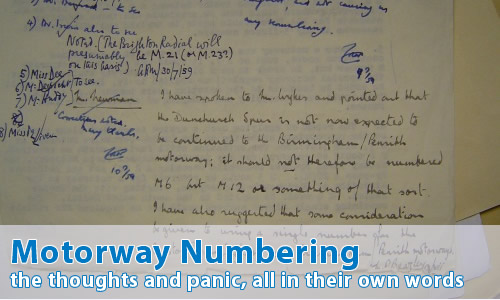

D. Greenwood - Traffic and Transport Planning B (TTPB)
The size of the motorway network envisaged intially was not thought to require more numbers than would be made available from the use of 2-digit numbers within each sector, i.e. ten 2-digit numbers per sector. In some of the sectors this situation will continue to apply but in those containing large conurbations it is now evident that there may well be a larger number of new urban motorways ultimately than has been anticipated hitherto. As an example, the plan attached to this paper illustrates some - but not all - of the motorways now envisaged for the SELNEC - West Riding area, within sector 6. The group of new proposed motorways shown on the plan will require more numbers than can be given on a 2-digit basis within the sector policy.
The result is that the accepted sector policy cannot be continued within a 2- digit numbering system. To retain 2-digit numbers must mean that we abandon the sector policy and use for, say, sector 6, some of the spare numbers which will quite certainly never be called upon for sector 3 or sector 1. The alternative would be to retain the sector basis for numbering but to allow 3-digit numbers where the 2-digit numbers have been exhausted.
While there are certain advantages in restricting motorway numbers to 2-digits for all areas, the abandonment of the sector policy which is involved would cause confusion on a wide scale. It is possible, however, to retain the sector system and to restrict 3-digit numbers to urban motorways. In this way the advantages of 2-digit numbers can be retained for the inter-urban motorway system as a whole. It is accordingly recommended that the sector system be retained, with 3-digit numbers agreed where necessary for urban motorways.
The sector map which has been shown to the Committee indicates how sector 6 extends eastwards from M6 to the East Coast, north of the line of M62. It is suggested that some clarification would be valuable here, particularly if as is not impossible a future development may be an extension of M1 northwards from Leeds. It is accordingly recommended that sector 6 should be restricted to the west side of A1, north of Leeds, and that the area between A1 and the East Coast should go with sector 1. The suggested revision of sectors 1 and 6 are shown on the plan produced to the Committee and the changes are recommended for approval.
Whoops.
Well, it's a fact that they didn't really see this coming seven years previously, when the main numbering decision was taken.
Personally, I like the fact that the section of England bounded by M62 on the south side, and A1 on the north side has been moved from its original sector 6 to sector 1. A quick look at a map of the country will reveal that it has affected a grand total of zero motorways. I'm sure there was a good reason for the decision, though I have no idea what that was!
J. E. Barnes - TTPB
It would be possible to retain the present sector policy for numbering, if we could use 3-digit numbers for, say, urban motorways in certain sectors. As you will see, the paper shows the SELNEC area as an example, although similar numbering problems could arise in London. For the rest of the urban areas of the country, however, it would probably be possible for us to retain 2-digit numbers, since many of the sectors will not have much call upon them. In explaining this situation, I asked the HEC whether they thought any fixed rule, intelligible to the public, could be adopted for numbering of urban motorways, which might in most cases be relatively short, but important for the area.
During the discussion, the HEC made it clear that they adhered to the views expressed by the 1961 HEC when considering the numbering system in the first place, i.e. "... the Committee ... thought that the most important test was what the motorist would find most convenient..." The HEC therefore agreed that the 2-digit numbering should remain for inter-urban motorways. Discussion centred on the way in which 3-digit numbering should be applied in areas such as SELNEC. Mr. Harris felt that the Manchester Outer Ring - to take this particular example - should be the limit of 2-digit numbering and that all road inside should have 3. Thus, Mr. Harris suggested that M64 shown on the plan should become M602 and that this pattern should be followed for all the motorways within the Outer Ring. I pointed out that, although in this particular case, this would form a neat pattern it would be difficult to follow it in the case of the other conurbations. Conceivably, the Birmingham parallel could be the roughly triangular area between M6, M5, and the new motorway to link M5 and M6 on the south of Birmingham. London could also reproduce the same pattern and, possibly, Liverpool. But, for the remainder of the urban areas of the country, there would normally be enough 2-digit numbers available and one therefore wondered whether we were justified in automatically using 3-digit numbers for all urban motorways.
As it turned out, of course, the only three digit number that actually fits into the idea for them is the mentioned M602!
None of the other three digit motorways are inside ring motorways...